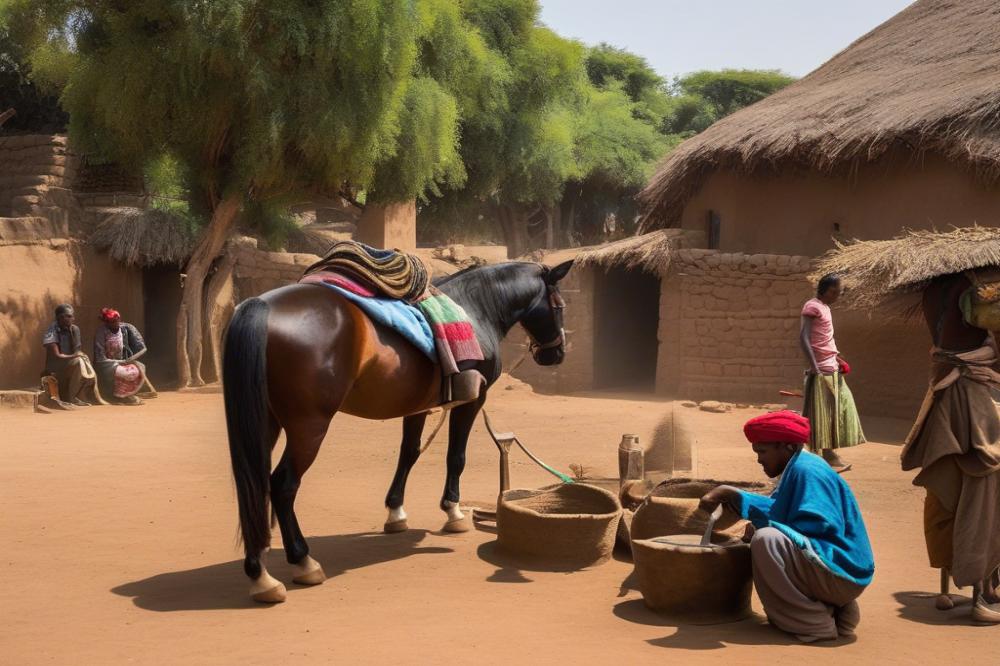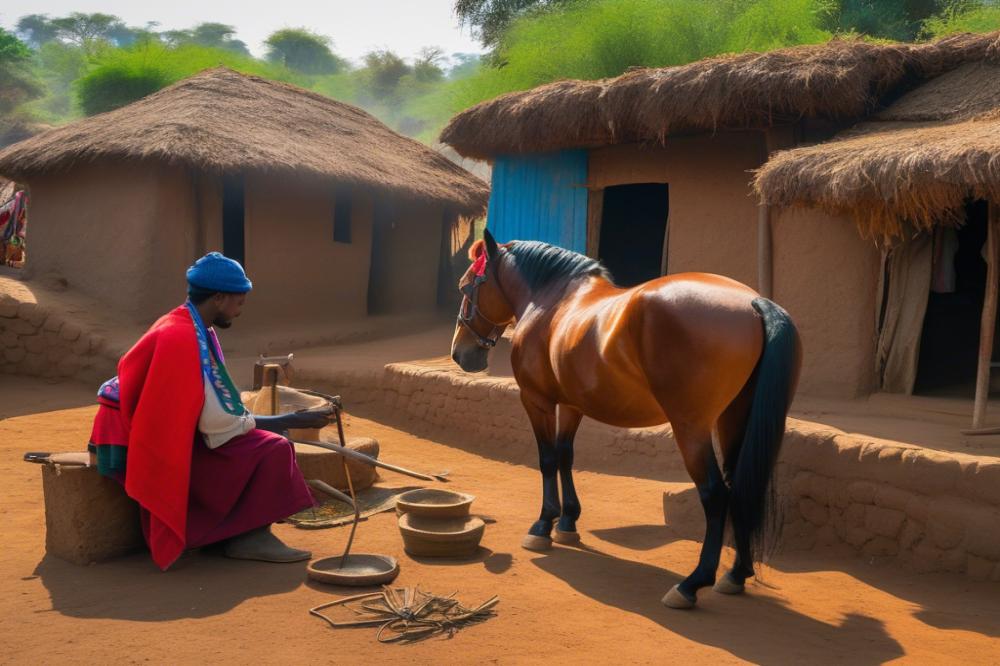hoof care in Ethiopia: The Role of local farriers in Keeping Horses Sound
Overview of hoof care in Ethiopia
In Ethiopia, hoof care plays a critical role in the overall health of horses. These animals are integral to many communities across the nation. Proper maintenance of their hooves contributes significantly to their well-being and performance. local farriers are often the unsung heroes in this process, dedicated to ensuring that horses remain sound and healthy for work and travel. Traditional methods of care coexist with more modern practices, creating a blend of techniques that reflects the culture of the region.
Importance of Horses in Local Culture and Economy
Horses occupy a special place in Ethiopian society. They serve as vital partners in agriculture and transport. Farmers depend on these strong animals to till land and carry heavy loads. Additionally, horses have a cultural significance, often appearing in local rituals and celebrations. The economy in rural areas thrives on the strength of horse power. This reliance makes it essential to prioritize their health and care. When horses are healthy, communities flourish alongside them.
Role of Farriers in Maintaining horse health and Soundness
Local farriers are key players in the quest for horse soundness. These skilled individuals possess the knowledge to address hoof issues effectively. Their expertise covers everything from trimming to shoeing horses. Farriers understand the importance of regular checks, which can prevent serious problems. They work tirelessly to keep horses performing at their best. Through their dedication, they contribute to the well-being of these crucial animals. Investing in hoof care means investing in the future of both horses and their owners.
Understanding Hoof Care

Hoof care plays a vital role in animal husbandry, especially for horses. It involves various practices aimed at maintaining a horse’s hooves. These practices are essential for the animal’s health and performance. Neglecting hoof care can lead to serious problems, including lameness and infections.
Two main components are vital in hoof management: trimming and shoeing. Trimming helps keep the hoof at a proper length and shape. This process usually requires skill and precision. Farriers must examine each hoof closely to decide how much to trim. Shoes, on the other hand, serve a protective function. They provide extra support and can improve traction on different surfaces. Not all horses need shoes, but many benefit from them during work or competition.
The health of a horse’s hooves directly affects its overall well-being. A horse with sound hooves is more likely to perform better. Poor hoof condition can lead to decreased mobility. This may affect the animal’s ability to graze or travel. Keeping hooves healthy helps prevent pain and discomfort. It also contributes to a horse’s lifespan and quality of life.
Local farriers in Ethiopia play an essential role in ensuring that hoof care is performed correctly. They possess skills passed down through generations. Their understanding of local conditions helps them provide valuable services. In rural areas, access to veterinary care may be limited. This makes the farrier’s role even more significant for horse owners. By keeping horses sound, farriers contribute to the livelihoods of many families relying on these animals.
The Role of Local Farriers

In Ethiopia, traditional farrier practices have deep roots. Local craftsmen serve as guardians of equine health. Their knowledge has been passed down through generations. Techniques often involve simple tools crafted by hand. Blacksmithing skills complement farriery, adding to the capacity to shape metal for horse shoes.
Community ties are vital in this work. Many farriers rely on local ingredients for making protective hoof coverings. Native plants and materials serve as alternatives to commercial products. This familiarity allows them to work effectively within their environment. Such practices reflect a profound understanding of both the animals and their unique needs.
Local knowledge plays an irreplaceable role in hoof management. Farriers understand the terrain and weather patterns, leading to better care. They can assess how local diets influence hoof health. Observations with each horse contribute to their expertise. Ongoing learning often occurs through informal networks and shared experiences.
Despite their skills, farriers face significant challenges. Limited access to modern tools can hinder effective treatment. Transportation difficulties make it hard to reach more remote areas. Many practitioners also struggle with a lack of formal training. This gap sometimes leads to inconsistent practices.
Economic factors add to the obstacles. Many horse owners operate on tight budgets. Farriers may find it challenging to set prices that reflect their expertise. This situation can lead to conflicts over service value. Access to education and support could enhance the profession significantly.
Techniques and Practices
Farriers in Ethiopia often rely on traditional techniques for hoof trimming and shoeing. Many utilize simple tools like knives, rasps, and hammers. These instruments help remove excess hoof material and shape the hoof to promote health. Local knowledge is deeply rooted in these practices, passed down through generations. Each farrier learns how to read the hoof’s condition, observing cracks or signs of disease.
Modern practices are gradually making their way into Ethiopia, sometimes blending with traditional methods. For instance, some farriers now use more advanced tools and techniques that can improve efficiency. Electric tools, such as grinders, might be employed alongside traditional hand tools. This mixing helps local farriers achieve better outcomes while maintaining their cultural roots in care for horses.
Sustainable practices have started to gain traction as well. Some farriers advocate for barefoot trimming, which allows horses to roam freely without shoes. This practice respects the animal’s natural behavior while reducing dependence on manufactured items. Also, using locally sourced materials for horseshoes highlights eco-friendly choices. Such efforts aim to create a balance between animal welfare and environmental consciousness.
Education plays a critical role in these practices. Workshops and training sessions teach farriers about both time-honored methods and modern advancements. Increased knowledge allows for improved hoof care, creating better outcomes for the horses. Through this blend of old and new techniques, farriers contribute significantly to the well-being of horses in Ethiopia.
Impact on Horse Soundness
Proper care of a horse’s feet is crucial for its overall health. Healthy hooves lead to better performance. When horses have sound feet, they can run, jump, and work without pain. Pain in the hooves can cause serious issues, making it hard for animals to perform even basic tasks. Helping horses avoid these problems benefits not just the animal but also the riders and owners.
Investing in farrier services can offer significant economic advantages for horse owners. Regular maintenance helps prevent expensive injuries and veterinary bills. Owners save money in the long run by protecting their animals from common issues caused by neglect. Horses that are maintained well can also compete better and last longer in their careers. This leads to higher returns on investment for those who depend on their horses for income.
Local farriers play an essential role in this process, providing tailored care suited for local conditions and styles of work. Each farrier brings skills that cater to the needs of the community. With their knowledge, they can advise owners on the best practices to keep horses healthy. Such guidance is often invaluable, especially in regions where resources may be limited.
Many successful communities have seen a rise in overall animal health when proper foot care is prioritized. By maintaining sound hooves, horses display improved performance and endurance. Increased soundness means that horses can work longer and healthier lives, which benefits everyone involved.
Training and Education
Current State of Farrier Education in Ethiopia
Education for farriers in Ethiopia is still developing. Many local practitioners learn through hands-on experience rather than formal training. As a result, knowledge about hoof care varies significantly. Some farriers may possess only basic skills, while others have more advanced techniques. Unfortunately, this inconsistency can lead to issues in horse health. The reliance on traditional methods often limits the understanding of modern practices. A structured program could help in standardizing skills across the country.
Opportunities for Training Programs to Improve Hoof Care
Several opportunities exist to enhance education for farriers. Community workshops could focus on essential skills such as trimming and shoeing. Local agricultural schools might introduce specialized courses. Collaborating with experienced professionals could benefit local farriers significantly. Online resources also present an avenue for self-education. These platforms can provide videos and manuals on the best practices in hoof care. Many practitioners express a desire for more training, showing a strong interest in improving their craft.
Collaborative Efforts with International Organizations for Skill Enhancement
International partnerships can play a crucial role in advancing farrier education. Organizations from different countries have expertise that could greatly benefit Ethiopian farriers. Bringing in experts for workshops can provide invaluable hands-on experiences. Moreover, these collaborations might lead to the development of a certification program. Such a program could standardize training and elevate the profession. Awareness of global practices can inspire local farriers to adopt new techniques. Through these international efforts, the quality of care for horses could see significant improvements over time.
Final Thoughts
Hoof care plays a crucial role in maintaining the overall health of horses in Ethiopia. Local farriers significantly contribute to this aspect by providing essential services that often go unnoticed. Their knowledge and skill are vital for keeping these animals sound and fit for work.
An increase in awareness about the importance of proper hoof maintenance is needed. Many horse owners may not realize how much this impacts horse health. Investing in farrier services can greatly enhance the well-being of equines, leading to improved performance and longevity. Educating communities about this need can help elevate the standards of hoof care across the country.
Looking ahead, there is potential for better hoof care practices in Ethiopia. Training programs for farriers can be implemented, ensuring they have the latest techniques at their disposal. This change could foster a new generation of skilled professionals who understand the intricacies of equine welfare. As more horse owners become aware of the benefits of regular hoof care, the demand for these services will likely rise.
The implications of enhanced hoof care are substantial. Healthy hooves mean healthier horses, which directly benefits the communities relying on them for transportation and labor. A well-maintained equine population bolsters local economies and improves the lives of many. In conclusion, promoting hoof care and supporting local farriers are essential steps towards ensuring the future health and productivity of horses in Ethiopia.



